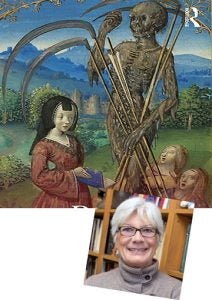Death in Medieval Europe

Back in the Middle Ages, popes were embalmed with spices and rubbed with a good white wine, wealthy people were often buried in more than one place, and cemeteries turned into brothels at night.
These tidbits come effortlessly from Joëlle Rollo-Koster, a University of Rhode Island history professor whose collection of essays, Death in Medieval Europe: Death Scripted and Death Choreographed, was published by Routledge this winter.
The essays by Rollo-Koster and other scholars explore the cultural effects of death and how it influenced everyday life, from mourning practices to commemorations. URI chatted with her recently about her research:
In the movie Batman v. Superman: Dawn of Justice, Superman has two caskets. What practice are we seeing?
People who saw the movie may not realize that they witnessed somewhat of a traditional medieval funeral, a reflection of what happened when princes and rulers were buried.
Late medieval institutions feared political transitions—they were dangerous and people tried to change the status quo—so when a leader died, institutions created the illusion of continuity. It’s summed up by “The king is dead, long live the king.” The person was buried in one casket, but a second, empty coffin was paraded as a symbol to show that you could mourn the dead man, but the institution continued regardless.
Tell us more about the use of spices in embalming.
I have studied how popes were embalmed. Chamberlains filled the mouth, ears and nose with cotton, oakum, myrrh, incense and aloe, if available. They rubbed the body with a “good white wine” heated with smelling herbs, or with a good Garnache wine. They stuffed the throat with herbs, spices and cotton and rubbed the body vigorously with balsam. And the famous medieval surgeon Guy de Chauliac gives us a list of embalming techniques that includes putting quicksilver (mercury) in the nostrils, ears and mouth to prevent the brain from liquefying.
A good medieval embalming allowed a corpse to be preserved (and thus viewed) for up to eight days. That was a feat!
Where were cemeteries in the Middle Ages?
Cemeteries were not hidden from view or enclosed within walls—they were social places, part of the town, even the setting for markets. People were known to drink and gamble there (medieval people loved playing dice), and most of all prostitutes plied their trades. Burial must not have been really deep, because there is also evidence that in Avignon when the Rhône flooded, bodies were unearthed and seen floating.
The church preached that resurrection was spiritual, but most folks assumed that resurrection would be physical. When the plague arrived and there was no space for bodies in cemeteries, ossuaries were built with at least a couple of leg bones and the skull, so everyone would have a chance at a full reconstitution for resurrection.
Why do we hide death in modern times?
There is tremendous discomfort with having serious discussion about death now. Look, for example, at the debate surrounding euthanasia. We see death in all the media, but even so we cannot conceptualize it as something real. It’s like a video game.
Medieval death was public, and people heard day and night that life afterward would be better, so why fear it? I do think that our modern aseptic and isolated deaths lack the comfort that death, at home, surrounded by friends and family, provided. Medieval people actually had the concept of a “perfect death.” It was a long, slow decay. The agony was prolonged so people would do their acts of contrition, pray, confess, be absolved and, finally, pass knowing that all would be well afterward. Sudden and quick death meant that God was punishing you, so you had no time to prepare for a safe passage.
 Home
Home Browse
Browse Close
Close Events
Events Maps
Maps Email
Email Brightspace
Brightspace eCampus
eCampus


